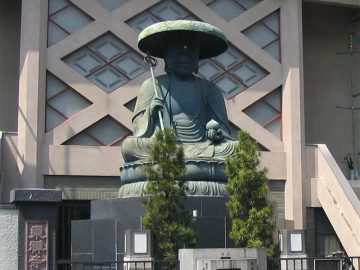
01. Founding Seated Statue of Jizo-Bosatsu
Metropolitan Historic Site
Tozen-ji Temple, 2 chome 12-13, Higashi-asakusa
02. Undisclosed according to the right holder's request.
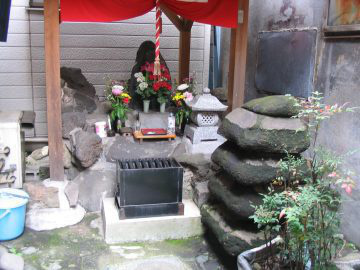
03. Mound of the Fleet Steed
2 chome 16-1, Higashi-asakusa
This mound is said to be the grave of the beloved horse of the 11th century samurai Minamoto no Yoshiie who passed here on his way to an expedition to the Tohoku region.
In an illustration from an early 19th century book, the mound is introduced in this light, and it also provides us with glimpses of the lifestyle of that period.
Presently the mound is carefully preserved through the efforts of the people in the neighborhood.
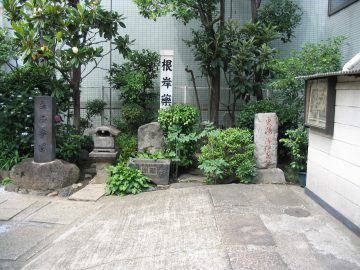
04. Uneme Zuka
Shussan-ji Temple, 1 chome 13-13, Kiyokawa
The characters "UNEME ZUKA" are carved in the upper part of the tombstone and the reason for building the mound is engraved below.
In the beginning of the Edo Period a young monk fell in love with a young prostitute named Uneme. The monk's master forbade him to see her, however, which to take his own life. Uneme, who was 17 years old, grieved so greatly over his death that she threw herself into the pond called Kagami-ga-Ike at a place known as Asaji-ga-hara. The next morning people who came to the pond to cut grass nearby found her body and buried it. The tombstone was erected by a writer named Ota Nanpo and his friends.
The tombstone was scorched by fire during World War II.
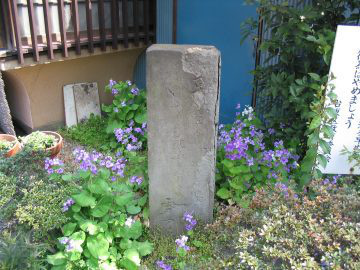
05. Monument to Takarai Kikaku
Shussan-ji Temple, 1 chome 13-13, Kiyokawa
This is a monument to the famous Haiku poet Takarai Kikaku.
The poem carved in the front face of the monument, erected in January 1696, was composed when he visited this temple along with one of his followers. It reads "KUSAKUKI WO TSUTSUMU HAMONAKI KUMOMAKANA"
Kikaku apprenticed himself to Matsuo Basho at the age of 14 or 15 and he quickly demonstrated his talent. He published a collection of his poems called "MINASHIGURI" in 1683. After Basho passed away, Kikaku developed a unique, inspired style of his own in the composition of Haiku poems and became the central figure of the Haiku world in the Edo Period. He died in 1707.
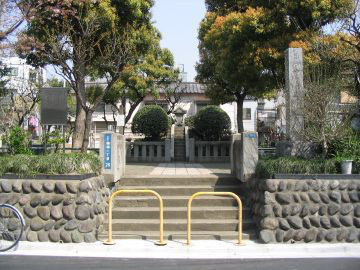
06. Myokizuka
Metropolitan Historic Site
1 chome 28-3, Hashiba
This place marks the site where the Ōshū Kaidō Road once passed through the field of Asaji-ga-hara. Myōkizuka takes its name from the Umewaka Legend. During the Heian Period (794-1185), the child of Yoshida Korefusa-Umewaka-was kidnapped by Shinobu no Tota. On the way to Oshu, Umewaka became very ill and is said to have passed away in this area. Looking for her child, Umewaka's mother came to this site where she learned of the youth's death from a villager. Legend has it that in order to grieve for her child's death the mother took holy orders with the Myoki hermitage. This is the subject of the Noh play Sumidagawa.
There is a stone monument atop the burial mound. The date inscribed upon the tablet is the "May 22nd, 1288" making it one of the oldest historical sites in the City. However, the relationship between the burial mound and the stone monument is not quite clear.
The Mokuboji Temple, still located on the opposite bank of the Sumida River (Sumida City, Tsutsumi dori) , also has a burial mound "Umewaka" (Metropolitan Historical Site) named after Umewaka and it is thought to be related to this mound.

07. Obake (Bogy) Jizo
Shogin-ji Temple, 2 chome 5-3, Hashiba
Once upon a time, this area was within the premises of Sosenji Temple. The bogy Jizo is located at a corner of the Sosenji Temple and initially it was called "baby-raising Jizo." But the Jizo, an image in stone, had a large hat and a large height of more than 3 meters. So, some people said that the hat moved in direction, and then they used to call it obake (bogy) Jizo.
According to the foundation stone of the Jizo, it is recorded that the Jizo was built in 1721 and broken into two pieces after the Great Kanto Earthquake but it was repaired with the head portion replaced.

08. Tomb of Hiraga Gennai
National Historic Site
2 chome 22-2, Hashiba
Hiraga Gennai was a scholar and author who lived in the middle of the Edo Period (1728 to 1779). Although he was not a particularly successful businessman, he made various inventions and took part in development of products for various purposes, including exploitation of mineral resources, production of ceramics and woolen goods. On the other hand, he did leave several literary works behind, such as books and dramas.
He committed a murder in November 1779 and died of illness in a prison on December 18. His body was buried in the Sosenji Temple that was situated in this area. The Sosenji Temple was moved to Azusawa in Itabashi City, Tokyo, in 1928, but the tomb of Gennai remained preserved in this area and was designated a national historical site in 1943.
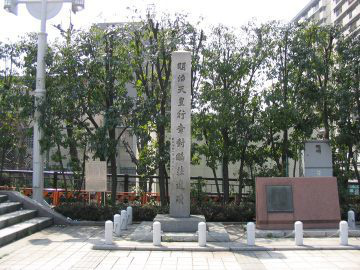
09. Remains of Taioso
2 chome 1, Hashiba
Taioso was the villa of Sanjo Sanetomi (1837-1891), statesman in the Meiji Period. He fell ill in October of 1873 and rested quietly in this villa, the Emperor Meiji was very anxious about his health and visited this villa himself to comfort Sanjo. This monument was created by a citizen who owned the villa later to commemorate the Emperor's visit. The villa was relocated to the Tama-Seiseki-Kinenkan at Tama City to allow the construction of the Shirahige Bridge in 1928.

10. Tomb of Ando Toya
Metropolitan Historic Site
Fukujyu-in Temple, 1 chome 16-2, Hashiba
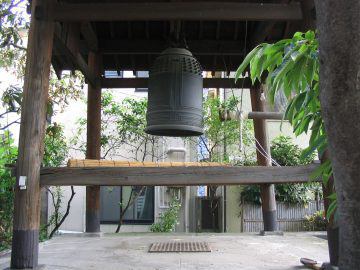
11. Copper Bell
Taito City Historic Site
Chosho-ji Temple, 2 chome 32-16, Imado
Choshoji Temple is a very old temple belonging to the Nichiren sect of Buddhism and is reported to be built either in 1279 or 1282. In former days the temple had an extensive precinct, a part of which faced to the Sumida River to the west of the temple. Once when the Sumida River flooded, all the temple edifices were washed away, and the copper bell sank to the bottom of the river. The people in the neighborhood called the depths where the bell sank "Kanega-Fuchi (Depths of the bell)." The present bell was cast in 1720, on which the history of Choshoji Temple and the legend of "Kanega-Fuchi" are inscribed.
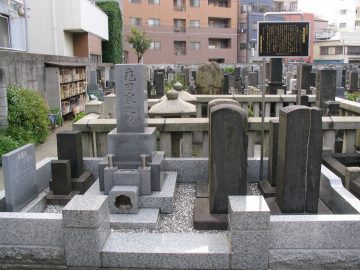
12. Tomb of Kameda Bosai
Metropolitan Historic Site
Syofuku-ji Temple, 2 chome 6, Imado

13. Monument of the Emperor Meiji Inscribed with His Poem
Sumida park, 1 chome 1, Imado
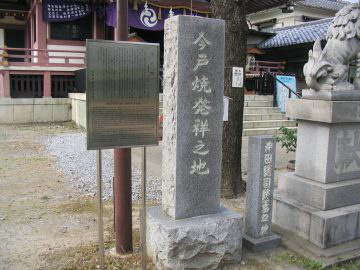
14. Imado Ware (Imado Yaki)
Imado Shrine, 1 chome 5-22 , Imado
Imado ware made in what is now called Imado in Taito City, was one of the most popular type of earthenware for vessels and figures during the Edo Period. The pedestals of the guardian dogs at the Imado Shrine, carry the names of Imado potters and the date of 1752 when these figures were presented.
Imado ware was said to have originated at the beginning of the Edo Period, however it was not until the end of the 18th century that it was given the name of Imado ware. As a result, it can be presumed that Imado ware was already being produced full scale during the first half of the 18th century. The production of old-fashioned roof tiles flourished along the banks of Sumida River. This production of Imado ware was depicted in "Edo Meisyo Zue" and in "Sumidagawa Choryu Zukan" currently being held at The British Museum.
In recent years, excavations at the ruins of Edo have uncovered earthenware vessels and dolls carrying names of potters of Imado ware and also roof tiles with the impressed seal of Imado.
The Great Kanto Earthquake and World War II Tokyo air raids forced almost all potters to move out of Taito City, leaving only one family, which still produces earthenware dolls of traditional figures. These include "maneki neko" known as fortune cats and "kuchi ire kitsune" known as good life foxes.













